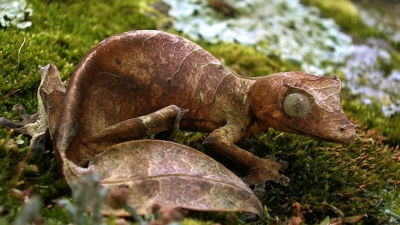
Scorpionfish
Scorpionfish, one of the most venomous fish in the world, are found across the world in warm waters. They are most common in the Indian and Pacific Oceans. They are also known as rockfish and stonefish as they commonly live among rocks. They are perch-like fish with large, spiny heads and strong, sometimes venomous. fin spines. While their spines protect them from predators, it is their colouring that helps them in hiding. They are carnivorous and generally sedentary. The fin spines, even ones without venom, can inflict deep, painful wounds. While some are dull in colour, others are brighter, often some shade of red. The largest members of the family grow about 39 inches long.
Walkingstick
Suddenly seeing a twig crawling down a tree trunk? It isn’t a twig but a walkingstick, also called stick insect. The stick-like trickster uses its appearance to save itself from enemies. They are commonly found in tropical and temperate (or mild) forests across the world. Though related to grasshoppers, crickets, and mantises, these crawlies are either brown, green, or black. They’re also the world’s longest insects. The largest one found was 22 inches long with its legs extended. They spend most of their time on trees, munching on leaves. When predators like birds approach, the bug tries to remain still to blend with the branches. However, if the predator manages to catch the bug by its legs, the insect can detach the leg and scuttle away. The leg will later regenerate, or grow back.
Camouflage
Also known as cryptic colouration, is a defence mechanism used by organisms to disguise their appearence, usually to blend/ in with their surroundings. This tactic is used to mask their location, identity and even movement. This helps the prey to protect themselves from predators.
Chameleon
Chameleons have the ability to change their colour and pattern. They are found in warm climates and in parts of the Middle East, southwestern Asia, and southern Europe, Madagascar nearly all of Africa, and parts of India and Sri Lanka. There are more than 200 species of chameleons, of which 76 are found on the island of Madagascar. Their diet consists of insects and plants, though some may eat rodents or small birds. They live in a range of habitats, including deserts, rainforests, and savannahs. The word chameleon comes from the Greek ‘khamai’ meaning on the ground, earth and leon’ meaning ‘lion’. probably because the head of some species resembles a lion’s mane. The distinctive features of these lizards are their telescopic eyes, grasping tail, colour-changing skin, and projectile tongue.
Great Potoo
The Great Potoo is a nocturnal bird of the American tropics. Its name is similar to its wailing cry, “po-TOO,” made by some species. Their patterns of grey, black, and brown plumage resemble tree bark. Their camouflage helps them to even sleep while perched out in the open during daylight During the day, the birds sleep, vertically perched and virtually indistinguishable from the dead branches they roost on They wake up at dusk with their huge, wide-open eyes capable of spotting moths and other flying insects in the dark. They are mainly solitary creatures and highly restricted nesters. Instead of building a nest, they choose a branch or stub with a crevice just enough to accommodate the single egg they lay.
Nightjar
Nightjar is a medium-sized bird that are mostly active at night feeding on flying insects. They have a protective colouring of grey, brown, or reddish brown. There are about 60 to 70 species of nightjars. They are found almost worldwide in temperate to tropical regions, except for New Zealand and some islands of Oceania. They do not make nests, instead deposit their eggs on the ground or on the leaf-covered floor of the woodland. Some of the species, mainly the North American nighthawks, have adapted to urban life and nest on flat gravel-covered rooftops. The nightjar’s soft plumage and variegated colouring help it blend in with its surroundings. Despite their skill at camouflage, some nightjar species are endangered.
Picture Credit : Google




